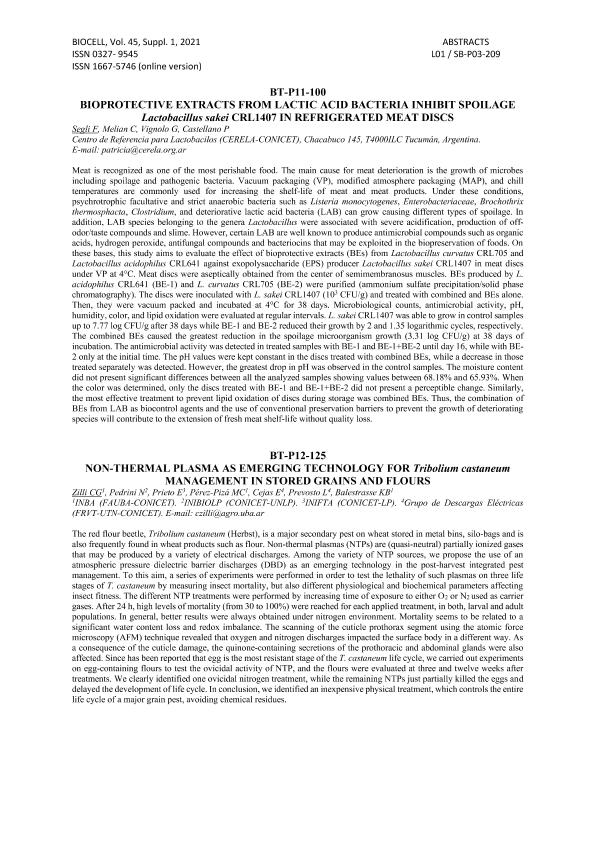Evento
Non-thermal plasma as emerging technology for Tribolium castaneum management in stored grains and flours.
Zilli, Carla Giannina ; Pedrini, Nicolás
; Pedrini, Nicolás ; Prieto, Eduardo Daniel
; Prieto, Eduardo Daniel ; Pérez Pizá, María Cecilia
; Pérez Pizá, María Cecilia ; Cejas, Ezequiel
; Cejas, Ezequiel ; Prevosto, Leandro
; Prevosto, Leandro ; Balestrasse, Karina Beatriz
; Balestrasse, Karina Beatriz
 ; Pedrini, Nicolás
; Pedrini, Nicolás ; Prieto, Eduardo Daniel
; Prieto, Eduardo Daniel ; Pérez Pizá, María Cecilia
; Pérez Pizá, María Cecilia ; Cejas, Ezequiel
; Cejas, Ezequiel ; Prevosto, Leandro
; Prevosto, Leandro ; Balestrasse, Karina Beatriz
; Balestrasse, Karina Beatriz
Tipo del evento:
Reunión
Nombre del evento:
LVI Annual Meeting Argentine Society for Biochemistry and Molecular Biology and XV Annual Meeting Argentinean Society for General Microbiology
Fecha del evento:
11/2020
Institución Organizadora:
Asociación Civil de Microbiología General;
Título de la revista:
Biocell
Editorial:
Tech Science Press
ISSN:
0327-9545
Idioma:
Inglés
Clasificación temática:
Resumen
The red flour beetle, Tribolium castaneum (Herbst), is a major secondary pest on wheat stored in metal bins, silo-bags and is also frequently found in wheat products such as flour. Non-thermal plasmas (NTPs) are (quasi-neutral) partially ionized gases that may be produced by a variety of electrical discharges. Among the variety of NTP sources, we propose the use of an atmospheric pressure dielectric barrier discharges (DBD) as an emerging technology in the post-harvest integrated pest management. To this aim, a series of experiments were performed in order to test the lethality of such plasmas on three life stages of T. castaneum by measuring insect mortality, but also different physiological and biochemical parameters affecting insect fitness. The different NTP treatments were performed by increasing time of exposure to either O2 or N2 used as carrier gases. After 24 h, high levels of mortality (from 30 to 100%) were reached for each applied treatment, in both, larval and adult populations. In general, better results were always obtained under nitrogen environment. Mortality seems to be related to a significant water content loss and redox imbalance. The scanning of the cuticle prothorax segment using the atomic force microscopy (AFM) technique revealed that oxygen and nitrogen discharges impacted the surface body in a different way. As a consequence of the cuticle damage, the quinone-containing secretions of the prothoracic and abdominal glands were also affected. Since has been reported that egg is the most resistant stage of the T. castaneum life cycle, we carried out experiments on egg-containing flours to test the ovicidal activity of NTP, and the flours were evaluated at three and twelve weeks after treatments. We clearly identified one ovicidal nitrogen treatment, while the remaining NTPs just partially killed the eggs and delayed the development of life cycle. In conclusion, we identified an inexpensive physical treatment, which controls the entire life cycle of a major grain pest, avoiding chemical residues.
Palabras clave:
Tribolium castaneum
,
Secondary pest
,
Flour
,
Non-thermal plasmas
Archivos asociados
Licencia
Identificadores
Colecciones
Eventos(CCT - SANTA FE)
Eventos de CTRO.CIENTIFICO TECNOL.CONICET - SANTA FE
Eventos de CTRO.CIENTIFICO TECNOL.CONICET - SANTA FE
Eventos(INBA)
Eventos de INST.DE INVEST. EN BIOCIENCIAS AGRICOLAS Y AMBIENTALES
Eventos de INST.DE INVEST. EN BIOCIENCIAS AGRICOLAS Y AMBIENTALES
Eventos(INIBIOLP)
Eventos de INST.DE INVEST.BIOQUIMICAS DE LA PLATA
Eventos de INST.DE INVEST.BIOQUIMICAS DE LA PLATA
Eventos(INIFTA)
Eventos de INST.DE INV.FISICOQUIMICAS TEORICAS Y APLIC.
Eventos de INST.DE INV.FISICOQUIMICAS TEORICAS Y APLIC.
Citación
Non-thermal plasma as emerging technology for Tribolium castaneum management in stored grains and flours.; LVI Annual Meeting Argentine Society for Biochemistry and Molecular Biology and XV Annual Meeting Argentinean Society for General Microbiology; Argentina; 2020; 1-1
Compartir



